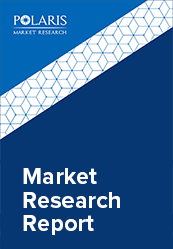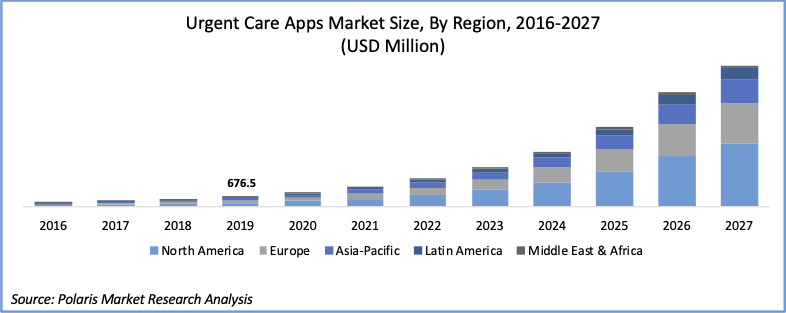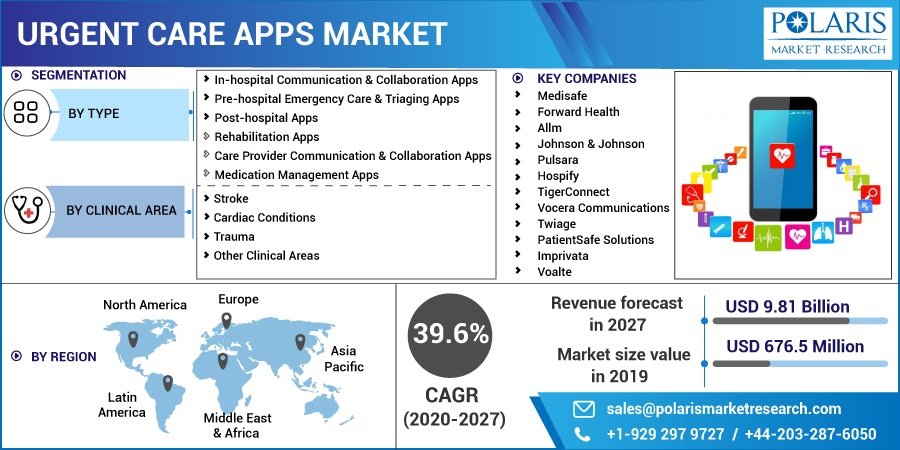
Urgent Care Apps Market Share, Size, Trends, Industry Analysis Report, By Type (In-hospital Communication & Collaboration Apps, Pre-hospital Emergency Care & Triaging Apps, and Post-Hospital Apps [Rehabilitation Apps, Care Provider Communication & Collaboration Apps, and Medication Management Apps]); By Clinical Area (Stroke, Cardiac Conditions, Trauma, and Other Clinical Areas); By Regions; Segment Forecast, 2020 - 2027
- Published Date:Oct-2020
- Pages: 101
- Format: PDF
- Report ID: PM1730
- Base Year: 2019
- Historical Data: 2016 - 2018
Report Summary
The global urgent care apps market was valued at USD 676.5 million in 2019 and is expected to grow at a CAGR of 39.6% during the forecast period. The market growth is due to the growing due to the rising adoption of the 3G, 4G, and 5G networks and the increasing penetration of the smartphones among all strata of population. The rise in the health awareness among the individuals and surge in the fitness activities in the hectic lifestyles of the individuals is the another key factor to fuel the growth.
Urgent care applications are advance software which are usually operated by the smartphones of the individual. The urgent care apps help to notify doctors and nurses about the emergencies with the patients. The patient can benefit in several ways by utilize the urgent care apps such as to seek medical care at home, office, or anywhere, to get insights at critical medical condition, etc.

Know more about this report: request for sample pages
Industry Dynamics
Growth Drivers
Urgent care apps are much beneficial to manage emergency medical situations which need to attend immediately. These apps are utilized for an additional pathway for an emergency and ordinary conditions which require instinct actions but are not for life-threatening situations. Apps provide an extensive and effective option to manage the health conditions such as stroke, trauma, pregnancy, cardiac diseases, and others.
 Know more about this report: request for sample pages
Know more about this report: request for sample pages
For instance, in November 2019, a digital healthcare startup Solv announced the launch of a mobile app which can help to access the app to treat the medical conditions and also can navigate insurance to the consumers. The increase in the mHealth due to the constant surge in the active participation of the patients towards their own health is also the key factor to drive the growth of the global market. The medical care apps provide an access to monitor the patients with ease and convenience at hospitals and house also.
The outbreak of the COVID-19 has led to appear the need of the modern techniques and applications to ensure the point-of-care of the patients on personalized healthcare delivery and consequently enriched the growth of the global market. For instance, in March 2020, Epic into the collaboration with OCHIN declared to introduce a new mobile app designed to aim front-line care coordination of the coronavirus pandemic. Urgent care apps offer several services with more flexible hours.
Urgent Care Apps Market Report Scope
The market is primarily segmented on the basis of Type, By Clinical Area, and by Geographic Region.
|
By Type |
By Clinical Area |
By Regions |
|
|
|
Know more about this report: request for sample pages
Insight by Type
On the basis of type, the global urgent care apps market is divided into in-hospital communication & collaboration applications, pre-hospital emergency care & triaging applications, and post-hospital applications. The post-hospital apps segment is further divided into rehabilitation apps, medication management apps, and care provider communication & collaboration apps.
The post hospital segment holds the dominant share in the global market owing to the ability to prevent therapeutics dosage lapses. The segments constitute an immense growth of the market owing to the rising demand for the efficient care and treatment at hospitals and house as well. The development in the technology in healthcare sector has surged the demand for the innovative techniques and applications to utilize it for the individual’s care.
Insight by Clinical Area
In the clinical area segment of the market; the trauma sub-segment holds the major share on the context of increasing cases of road accidents which majorly need the emergency and trauma care due to the rising awareness of the healthcare industry towards addressing the trauma in the patients.
The cardiac conditions segment is anticipated to thrive with the significant growth during the forecast period due to the benefits of expanding reach of the doctor and patients in the medical condition. For instance, in September 2017, the company MyMedicNow declared to launch a medical care app to enable the patients to reach out to the doctors at any time for the medical situation.
Geographic Overview
Geographically, North America anticipates holding the dominant share in the global market owing to the high usage of mobile health applications and the rising initiatives taken by the government in the healthcare industry. The rise in the awareness of the healthcare industry and the constant increasing needs of the patients leads to augment the growth of the global market in the North America region. For instance, in September 2019, the company Duke Health declared to introduce a new desktop and mobile application, telehealth urgent care app that allows patients to keen 24 X 7 virtual urgent care.
Additionally, the growth of the Asia Pacific market is expected to secure an expeditious surge in the recent former period. The outbreak of pandemic situation has raised the need for the virtual care and treatment in India which leads to escalate the growth of the global market in the Asia-Pacific region. For instance, in April 2020, the Health and NITI Aayog Ministry introduced guidelines for Telemedicine about the outbreak of COVID-19 in India due to the major challenges in the healthcare industry. The released guidelines by the legal authority favor in terms of cost saving, proper maintenance of documentation and records, effective treatment and consultation at any place, etc.
Several startups companies are taking an initiative in order to deliver the most extensive services of the virtual care application, complementing the region’s growth. For instance, July 2020, a Mumbai based startup company, WONDRx has launched a remote search and connection health app for all the healthcare providers and also benefits to the patients. The company allows the free access of the app till September 2020 by the patients.
Competitive Insight
The key players in the global urgent care apps market employing agreements, partnerships, mergers & acquisitions, and collaboration to get foothold in the market. For instance, in January 2019, the company Johnson & Johnson partnered with NXT Biomedical Therapeutic Device Incubator to design virtual care technologies and provide benefit to the patients have healthier lives.
Some of the major players operating the global market include Medisafe, Forward Health, Allm, Johnson & Johnson, Pulsara, Hospify, TigerConnect, Vocera Communications, Twiage, PatientSafe Solutions, Imprivata, Voalte, Alayacare, Siilo, Pivot Design Group, and Argusoft. The market leaders are adapting the strategy of launches of new apps to retrieve the highest market share. For instance, in October 2018, the company Pulsara add on the modern features and technology in the existing Pulsara mobile communication app to treat the uncertainties related to sepsis modules, trauma, and cardiac arrest.
License and Pricing
Purchase Report Sections
- Regional analysis
- Segmentation analysis
- Industry outlook
- Competitive landscape
Connect with experts
Suggested Report
- Precision Guided Munition Market Share, Size, Trends, Industry Analysis Report, 2022 - 2030
- Wrapping Machine Market Share, Size, Trends, Industry Analysis Report, 2021 - 2028
- Indoor Location Market Share, Size, Trends, Industry Analysis Report, 2022 - 2030
- Industrial Burner Market Share, Size, Trends, Industry Analysis Report, 2022 - 2030
- Hematologic Malignancies Therapeutics Market Research Report, Size, Share & Forecast by 2018 - 2025

